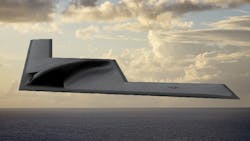WASHINGTON – The future U.S. Air Force B-21 stealth bomber aircraft project has taken another key technological step toward being ready for war, through integrated computer automation to streamline information, improve targeting, and offer pilots organized warzone information in real-time. Kris Osborn at Warrior Maven reports. Continue reading original article
The Military & Aerospace Electronics take:
3 June 2020 -- Air Force and Northrop Grumman developers recently completed an essential software-empowered process intended to bring greater levels of information processing, data management and new measures of computerized autonomy, according to published statements from Air Force Acquisition Executive William Roper.
Through virtualization and software-hardware synergy, B-21 sensors, computers and electronics can better scale, deploy and streamline procedural functions such as checking avionics specifics, measuring altitude and speed and integrating otherwise disparate pools sensor information.
In effect, it means war-sensitive sensor, targeting and navigational data will be managed and organized through increased computer automation for pilots to make faster and more informed combat decisions.
John Keller, chief editor
Military & Aerospace Electronics



